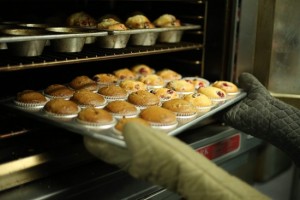
Most cooking recipes that include baking or roasting in the process advise you to preheat the oven before using it. Beginners often ponder over two questions when it comes to that: “Why is it necessary to preheat an oven?” and “How long to preheat the oven?”. Both seem like silly questions, and some people even skip this step, but what difference does it make?
Why is it necessary to preheat an oven?
There’s actually a pretty scientific explanation about why preheating the oven is important. Chemical reactions occur when you cook food and they may vary depending on the temperature inside the oven. In other words, if you want to achieve the right balance and taste, you must reach the right cooking temperature. Also, in order to ensure food safety, you need to cook food for a certain amount of time at a certain temperature. There are even recommended cooking temperatures for most types of dishes, so in order to reach it, you must first preheat the oven.
Preheating the oven is also related to the time needed for the dish to cook. If you put the meal in a cold oven, it will take longer to cook. Not to mention that you might end up with an undercooked dish that’s burnt at the bottom and barely cooked at the top, or the middle is ready but the rest isn’t.
For example, most pastries cook at a high temperature in a short time span. If you put them in a cold oven, they won’t rise and will end up cooked in the middle only. It’d be a cooking disaster and you’ll have to toss them in the trash bin. Another example with meat meals – when you don’t preheat the oven and put the meat inside, you’ll be preheating both the dish and the oven at the same time. This will result in water evaporating from the meat and it will most likely turn drier and less succulent rather than juicy and delicious.
How Long to Preheat the Oven?
You already learned why it’s important to preheat the oven before cooking now let’s see how long to preheat the oven before placing your dish inside.
When you preheat the oven you make the surface inside reach the temperature needed for the preparation of the food. Walls, racks, floor, door, and top must be evenly heated in order to cook the food at the same temperature from all sides.
Most ovens nowadays do have a light indicator that shows when the desired temperature has been reached and you can place the food inside. However, different types of ovens take a different amount of time to preheat. When the right temperature is reached, there’s a little thermal mass that goes away when you open the oven door. This helps you not to lose all of the heat when you place a colder dish inside.
For example, an aluminium sheet with a few cookies at room temperature won’t cause the temperature inside the oven drop as much as a 25-pound turkey that’s been resting in the fridge for a couple of hours.
It’s also good to know that ovens with a large baking stone at the bottom take longer to preheat evenly. This happens because the stone doesn’t heat up as fast as the rest of the oven. Also, poor insulation contributes to slower preheating. Most ovens heat up in 15-20 minutes, so it useless to wait longer. This is enough time for the surfaces and air in the oven to reach the temperature needed.
Tip: If you want to save on your electricity bill, have a queue of things to cook in the oven one after another. If your oven is bigger, you can also prepare a few things at the same time, as long as it’s not fish and cupcakes, for example.


